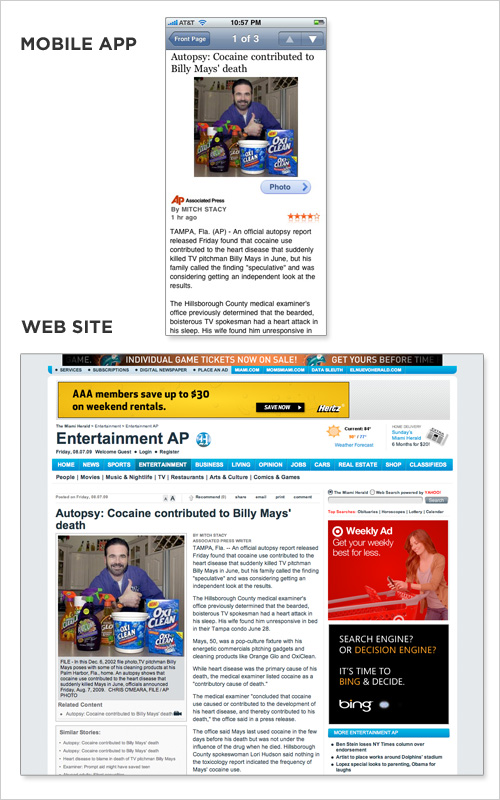Today the appearance of a motorcar is a most important factor in the selling end of the business—perhaps the most important factor— because everyone knows the car will run.
— Alfred P. Sloan, CEO General Motors
“In most people’s vocabularies, design means veneer. It’s interior decorating. It’s the fabric of the curtains of the sofa. But to me, nothing could be further from the meaning of design. Design is the fundamental soul of a human-made creation that ends up expressing itself in successive outer layers of the product or service.”
— Steven P. Jobs, CEO, Apple Computers
With the passing of Steve Jobs, a lot has been said about the impact that he’s had on a wide range of industries. But it’s pretty much agreed that his most significant contribution has been to show how important design, done at a really deep level, is to the success of a modern company.
I think the two quotes above illustrate perfectly the shift in the way that people view design in the post Steve world.
The way things were
The quote up top is from Alfred Sloan, CEO of a booming mid 20th century General Motors. Following that is Steve Jobs, creator of the most successful post-industrial company of the early 21st century. To Sloan, design was merely a “veneer”; a way of differentiating one car maker’s product from the next (and of making next year’s model more desirable than this one’s). In a world bounded by material constraints, a consumer was limited by cost to about one car per household; and the cost of switching was high. Once you’ve been seduced by the veneer of the product you are stuck and the conversation needn’t go further.
Buddy, can you spare a minute?
On the internet, there are dozens of web sites competing in any space. Ad-based and freemium models mean that the cost of ownership is as low as creating an account, and the cost of switching is so low that users can choose to use several competing products simultaneously. In a marketplace of infinite, low cost choices, what is scarce is not the product; what is scarce is the user’s own attention.
When attention is the barrier to user adoption, designed experiences have to go deeper. Everyone knows the car will run, but how well it runs and how it feels to run it make the difference between an active, engaged and productive user and a lost sale to a competitor. A well designed user experience can capture the attention of users and convince them to spend their precious time with your product.
Steve Jobs realized this, and he made sure that every aspect of the experience with an Apple product was thought through; that his products were appreciative of the time we spend with them.
Rock and Roll all night
Other companies are demonstrating that they have learned from Jobs:
To me, the most fascinating thing about Facebook’s f8 keynote was how focused it was on design. Despite the wealth of powerful new technology behind the new Timeline profile design the discussion was mostly about usability and user experience. They even closed the keynote with an amazing mini biography of internet-famous designer Nicholas Felton (from about 1:24 to 1:37 in the video).
Luke Wroblewski’s Mobile First manifesto has gained a lot of traction recently. One of the central observations of Mobile First is that mobile forces you to focus. Limited screen real-estate and distracted users mean that designers have to focus more on giving the user a productive experience. The design insights gleaned from building mobile first can be folded back into providing a lean and usable desktop experience as well. In an endless world of apps, it’s no longer enough to throw every little feature into your product; to create good design, you have to think about the user’s needs first.
I love the Little Big Details blog because it shows how much attention companies of all sizes are paying to design. It also shows that design is not just a nice colour palette or an eye-grabbing logo; it’s the little things that you might not even notice that add up to a great overall experience. From scrolling through the posts, you can also tell that despite their reputation for cold, metrics-driven product design, Google gets it too.
The river I stand in
When I say that a deeper approach to design is about capturing busy users’ attention what I am saying is this; good design can give the user back the one thing that we can never regain; time. We can optimize our designs to help the user get work done faster by optimizing workflows, providing useful short cuts, tightening feature sets and attending to many other tiny details. In cases where something can’t be made faster we can at least strive to make the experience more enjoyable by reducing visual clutter, leaving intuitive visual cues and providing helpful feedback amongst other things.
It is this magic ability of design to create more time that makes good design such a valuable commodity in today’s market where a user’s time and attention is the only scarce resource.
* The title of this post is a reference to Prince’s terrific album Sign o the times, which is a great way to spend your time.

